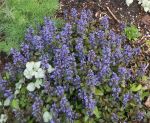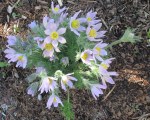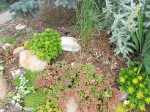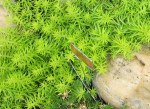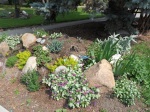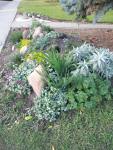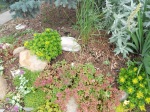Ajuga reptans
January 20, 2015
According to the Wikipedia article Ajuga reptans,
“Ajuga reptans, commonly known as bugle, blue bugle, bugleherb, bugleweed, carpetweed, carpet bungleweed, common bugle, is an herbaceousflowering plant native to Europe. It is invasive in parts of North America. Grown as a garden plant it provides useful groundcover. Numerous cultivars have been selected, of which ‘Caitlin’s Giant’ has gained the Royal Horticultural Society‘s Award of Garden Merit.[1]“
Ajuga reptans ‘Chocolate Chip’ Ajuga Bugle Rampant Bugleweed 12 June ’11 ID 489 Spruced Up Welcome Garden
Ajuga reptans ‘Chocolate Chip’ Ajuga Bugle Rampant Bugleweed 2 July ’13 ID 1293 Spruced Up Welcome Garden
Spruced Up Welcome Garden
January 20, 2015
Spruced Up Welcome Garden
Under construction
- Ajuga reptans ‘Chocolate Chip’ Bugleweed 12 June ’11
- Pasque flower 29 May ’14
- stonecrop
- Angelina Sedum
- lamium, sedums, thyme
- lamium, Iris, geranium, sedums
- sedums, geranium, thyme, Iris
- Stonecrop
yarrow, sedum, creeping lemon thyme, Alpine Aster, purple lamium, lamium ‘Herman’s Pride’, Arctostaphylos uva-ursi ‘Vancouver Jade’ ‘Vancouver Jade’ kinnikinnick or bearberry from Sunnyside Nursery (bearberry ‘variegrated’), beardtongue, iris germanica, mugwort, sticky geranium, calamagrostis (feather reed grass) ‘Karl Foerster’, pansies, angelina sedum rupestre (Angelina stonecrop), Sedum ‘Summer Glow’, Blue Spruce stonecrop, white clover, 
 |
White clover |
| Ajuga reptans ‘Chocolate Chip’ | |
 |
Penstemon digitalis ‘Husker Red’ |
 |
Stonecrop Angelina |
 |
Dragon’s Blood Sedum |
 |
Lamium |
Echinacea purpurea (eastern purple coneflower or purple coneflower)
January 20, 2015
- Echinacea 31 August ’14
- Echinacea purpurea 12 August ’14
- Echinacea purpurea September 19, 2011
- Cornflower, snow-in-summer, phlox 23 June ’14
Echinacea purpurea (eastern purple coneflower or purple coneflower) “Blue flowers“; See Wikipedia; “Melanie’s Medley“;
Walking Onion, Egyptian onion, Perennial Onion cepa x proliferum
January 20, 2015
Walking Onion, Egyptian onion, Perennial Onion cepa x proliferum
By 12 August my prolific perennial onions have already been shared with others and I still have lots of bulblets. Visitors to the garden are always fascinated by the way these walking onions bowed over by the weight of the clusters of topsets, if left on their own, can plants themselves for next year’s harvest.
I received mine from a very dear friend Ed, whose garden dates back at least to the 1980s? Since then I have been able to share a lot as well. They are leggy plants and fall over with the weight of the topsets so the need a special place in the garden. I have them with my chives for now.
In her article published in Calgary Gardening Janet Melrose described how the perennial onion grows so well in Calgary’s climate. It is a member of the Allium genus, known as “tree onion, topset onion, walking onion, Egyptian onion and perennial onion.” It is also named “A. cepa var. bulbiferum, viviparum, multiplicans, proliferum.”
Although Melrose recommends fall transplanting, they seem to be so hardy they survive planting in spring and even in summer.
Melrose is unsure of the origin of the name Egyptian onion but did mention that at the time of the Pharoahs, Egyptians believed that “the spherical shape of the bulb and concentric rings of the onions represented eternal life,” but she did not think that was the reason for this common name.
Melrose mentioned that the early leaves are mild and delicious, tasting like spring onions. The topsets are spicy. In early fall the “pungent shallot-looking bulbs” can be harvested.
References
Melrose, Janet. “Edible Portrait: Perennial Onion.” Calgary Gardening. Calgary Horticultural Society. August/September 2014. Volume 28. Issue 7. Page 5.
Sedums stonecrop
January 20, 2015
- Sedum July 2013
- Sedum July 2013
- Angelina Sedum
- stonecrop
- Sedum and Thyme ‘Pink Chintz’
- Sedum
- Sedum rupestre Stonecrop Blue Spruce
- Stonecrop
- lamium, Iris, geranium, sedums
- Sedum; September Surprise; June Blossoms; yellow blossoms;
- Dragon’s Blood Sedum, “Spruced Up Welcome Garden“, Gift to the Street; “Lilac Lane”; “Tara’s Island“
- Sedum rupestre Stonecrop Blue Spruce Pink Potential
- Angelina sedum rupestre, Sedum reflexum See Heritage Perennials plant identifier
- Variegrated sedum
- Dragon’s Blood Sedum
- ‘Autumn Joy’ gained the Royal Horticultural Society’s Award of Garden Merit (AGM), “Spruced Up Welcome Garden.” ‘Autumn Joy’ is part of the Sedum Herbstfreude Group.
According to Heritage Perennials,
“… a ‘Herbstfreude’. The border varieties of Stonecrop are a dependable choice for the late summer and fall garden, offering foliage interest earlier in the season, then a colourful display of flowers in the fall. Autumn Joy is by far the most popular of these, a familiar sight when it begins to produce green broccoli-like buds in mid-summer, which gradually open into enormous dusty-pink flower heads, finally deepening to rich bronzy-red. Even the dead flower heads have good winter effect. In rich soils, plants may be pinched in June to prevent floppiness. A classic perennial!” Heritage Perennials
According to Wikipedia
“Sedum is a large genus of flowering plants in the family Crassulaceae, members of which are commonly known as stonecrops. The genus has been described as containing up to 600 species [2] of leaf succulents that are found throughout the Northern Hemisphere, varying from annual and creeping herbs to shrubs. The plants have water-storing leaves. The flowers usually have five petals, seldom four or six. There are typically twice as many stamens as petals. A number of species, formerly classified as Sedum, are now a separate genus Hylotelephium.
Well known European Sedums are Sedum acre, Sedum album, Sedum dasyphyllum, Sedum reflexum (also known as Sedum rupestre) and Sedum hispanicum… Numerous hybrid cultivars have been developed, of which the following have gained the Royal Horticultural Society’s Award of Garden Merit:’Herbstfreude’ (‘Autumn Joy’), ‘Bertram Anderson’, ‘Matrona’, ‘Ruby Glow’.”

